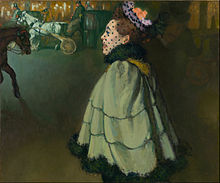
Louis Émile Anquetin (26 January 1861 – 19 August 1932) was a French painter.
Anquetin was born in Étrépagny, France, and educated at the Lycée Pierre Corneille in Rouen.[1]
In 1882 he came to Paris and began studying art at Léon Bonnat's studio, where he met Henri de Toulouse-Lautrec. The two artists later moved to the studio of Fernand Cormon, where they befriended Émile Bernard and Vincent van Gogh.[2]
Around 1887, Anquetin and Bernard developed a painting style that used flat regions of color and thick, black contour outlines. This style, named cloisonnism by critic Édouard Dujardin, was inspired by both stained glass and Japanese ukiyo-e. One example of this can be seen in Avenue de Clichy: Five O’Clock in the Evening, argued by Dr. Bogomila Welsh-Ovcharov as being inspiration for Van Gogh's famous Cafe Terrace at Night.[3]

He eventually fell from the public's eye after abandoning the modern movements, opting instead to study the methods of the Old Masters. Thus, Anquetin's works following the mid-1890s, such as Rinaldo and Armida, were especially Rubensian and allegorical in nature. In 1907 he met Jacques Maroger, a young artist who shared his interest, with whom he collaborated.
Later in life, Anquetin wrote a book on Rubens, which was published in 1924. He died in Paris.

